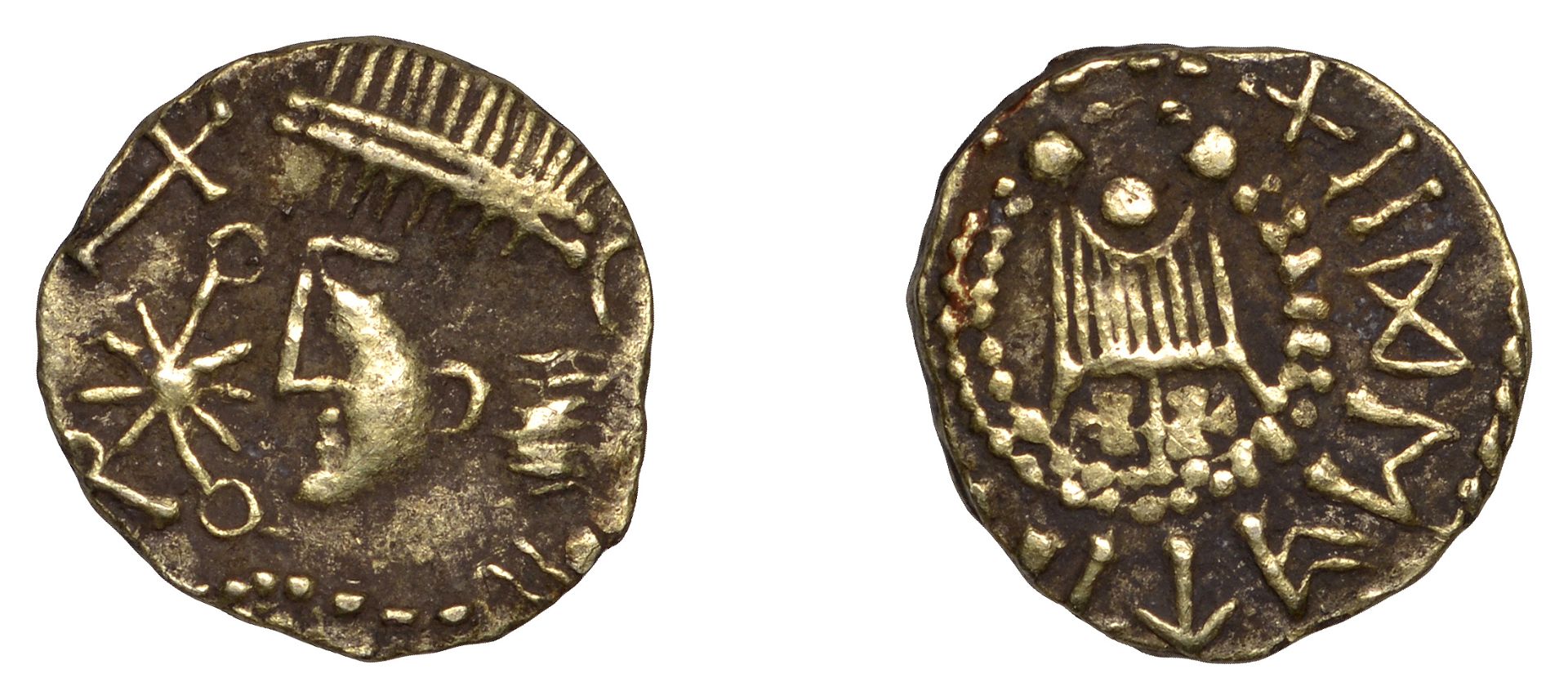Early Anglo-Saxon Period, Gold Shilling or Thrymsa, Post-Crondall period, c. 650-70, East Anglian Trophy series, ‘Runic Ring-Bearer’ type, armoured bust left, double-diadem high across radiate hair, heavenly cross before face, star ornament with connected rings below, rev. [–]ᛚá›áš©á›–ᛗᚻᚷ [ltoedhg] around double pelleted circle containing Roman trophy with two crosses below, 1.18g/9h (Marsden 20 = MEC 8, 14 = GCASE 780, same dies; SCBI Abramson –; SCBI BM –; Sutherland –; Metcalf –; N –; S 766). Light earthen deposits, good very fine with the obverse well-centred and struck up; only the second true specimen to be recorded and presumably unique to commerce, extremely rare thus £6,000-£8,000 --- Provenance: Found near East Bergholt, Suffolk, c. 1998 (EMC 2023.0098) English gold coins of the seventh century remain remarkably scarce. Despite the efforts of metal detectorists, it is becoming increasingly clear that few will ever be found, and this holds particularly true in the case of the East Anglian ‘Trophy’ series. Around two dozen specimens have been recorded, struck from just five obverse dies. Clearly this was not a large-scale operation, and it did not produce a currency suited for significant circulation. Unusually for this period, the obverse designs employed for the ‘Trophy’ series are not derived from Roman prototypes. Rather, these are original compositions of the mid to late seventh century, presumably imbued with significance recognisable to contemporaries. The design carried on the specimen offered for sale here represents an intriguing variation on the normal arrangement. While the diademed and cuirassed bust remains much the same, the orientation has been reversed, and the cross and hand motif seen on substantive ‘Trophy’ series is replaced with something altogether different. Here, a large floating cross occupies the upper part of the field below which is a star-shaped motif, with two of the radiate limbs terminating in rings, with another free-floating limb terminating in a ring directly underneath. Given its unusual and deliberately Christian iconography, Metcalf felt able to relate the substantive ‘Trophy’ series (with its cross and hand motif) to a specific event. An account of the consecration of Medeshamstede Abbey (Peterborough) in the mid 660s records that witnesses, including king Wulfhere, attested the charter ‘with their finger on Christ’s cross’, and it is to this episode that the ‘Trophy’ series has been attributed. However, such an arrangement does not sit comfortably with the known find-spots for the issue, which instead indicate a pattern of circulation around coastal East Anglia with a particular cluster in the proximity of Ipswich, and allows little room for explaining the star and ring variants. On the reverse our coin carries the eponymous trophy scene adapted, like many of the numismatic motifs from this period, from a coin of the late Roman Empire. However, once again there is a dramatic departure from the arrangement seen within the substantive part of the ‘Trophy’ issue; the ordinary Latin legend has been replaced by runic script, a feature known from only one other true specimen (now housed in the Fitzwilliam Museum) and a contemporary plated forgery. Unfortunately, this runic legend has posed difficulties, and its meaning remains unexplained. Nevertheless, the very use of a runic legend is intriguing and may well demonstrate a desire amongst the elite of East Anglia to embrace their pre-Christian, and pre-Latin, traditions. Recognition of this prompts a possible explanation for the enigmatic star and ring motif seen before the bust on our coin. As Marsden notes, ‘The annulets could well represent rings. The bestowing of rings by lords to their sworn followers was a feature of Anglo-Saxon society and is reflected in the heroic poetry of the age’…’If - as seems likely - the portraits represent the king of East Anglia, then they mark him out as both a Christian lord and perhaps also a ring-giver in the tradition of his ancestors’. Works cited: Abramson, T., Gold Coins of Anglo-Saxon England, 2022 Marsden, A. ‘East Anglia’s Earliest Issues; the Trophy type shillings’, in Cæaromagus 120, 2016 Metcalf, D.M. Thrymsas and Sceattas in the Ashmolean Museum, 3 vols, 1993–4 Naismith, R., Medieval European Coinage, with a catalogue of the coins in the Fitzwilliam Museum, Cambridge, Vol. 8: Britain and Ireland (c.400-1066), 2017 Woods, A.R., ‘The production and use of coinage in East Anglia 500-800, in BNJ 91, 2021



